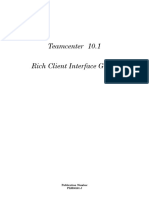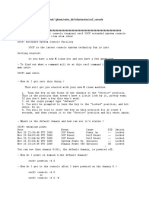0 ratings0% found this document useful (0 votes)
6 views1. Python Introduction (2)
Python is a high-level, interpreted, object-oriented programming language known for its readability and versatility, widely used in web development, data science, and automation. Key features include dynamic typing, extensive libraries, and strong community support, while its disadvantages include memory inefficiency and slower execution speed. Python was created in the 1980s by Guido van Rossum, with its first version released in 1991, and the latest version, Python 3.11, released in 2022.
Uploaded by
rushikeshkonde1Copyright
© © All Rights Reserved
We take content rights seriously. If you suspect this is your content, claim it here.
Available Formats
Download as DOCX, PDF, TXT or read online on Scribd
0 ratings0% found this document useful (0 votes)
6 views1. Python Introduction (2)
Python is a high-level, interpreted, object-oriented programming language known for its readability and versatility, widely used in web development, data science, and automation. Key features include dynamic typing, extensive libraries, and strong community support, while its disadvantages include memory inefficiency and slower execution speed. Python was created in the 1980s by Guido van Rossum, with its first version released in 1991, and the latest version, Python 3.11, released in 2022.
Uploaded by
rushikeshkonde1Copyright
© © All Rights Reserved
We take content rights seriously. If you suspect this is your content, claim it here.
Available Formats
Download as DOCX, PDF, TXT or read online on Scribd
You are on page 1/ 2
What is Python?
Python is a high-level, interpreted , object-oriented, dynamically-typed programming language.
Python is widely used for web development, Data Science, data analysis, artificial intelligence & Machine
Learning, scientific computing, Web Scrapping and Automation, Game Development, and more.
Key features of Python:
1. Easy to Read and Write: Python has a clean and straightforward syntax, making it accessible to
beginners and efficient for experienced developers.
2. Interpreted Language: Python code is executed line by line, which makes debugging easier and
allows for quick testing and iteration.
3. Dynamic Typing: Variables in Python do not need explicit declaration to reserve memory space, and
the type is determined at runtime.
4. Extensive Libraries and Frameworks: Python has a vast standard library and a wide array of third-
party libraries and frameworks (like Django, Flask, NumPy, pandas) that extend its capabilities.
5. Community Support: Python has a large and active community, which means extensive
documentation, tutorials, and support are readily available.
6. Cross-Platform: Python is available on many platforms (Windows, macOS, Linux), making it a
versatile choice for development.
7. Open Source: Python is free to use and distribute, even for commercial purposes, under the Python
Software Foundation License.
Advantages of Python:
Easy to learn, read, and understand
Versatile and open-source
Improves productivity
Supports libraries
Huge library
Strong community
Interpreted language
Disadvantages of Python:
Restrictions in design
Memory inefficient
Weak mobile computing
Runtime errors
Slow execution speed
History of Python
Python was created in 1980s by Guido van Rossum. During his research at the National Research Institute
for Mathematics and Computer Science in the Netherlands, he created Python – a super easy
programming language in terms of reading and usage. The first ever version was released in the year 1991
which had only a few built-in data types and basic functionality.
Later, when it gained popularity among scientists for numerical computations and data analysis, in 1994,
Python 1.0 was released with extra features like map, lambda, and filter functions. After that adding new
functionalities and releasing newer versions of Python came into fashion.
Python 1.5 released in 1997
Python 2.0 released in 2000
Python 3.0 in 2008 brought newer functionalities
The latest version of Python, Python 3.11 was released in 2022.
What is CMD
CMD, short for Command Prompt, is a command-line interpreter application available in Windows
operating systems. It allows users to execute commands to perform specific tasks without using a graphical
user interface (GUI). CMD provides a text-based interface for interacting with the operating system,
executing scripts, and running batch files.
Hello World Program in Python
# Python code to print "Hello World"
print ("Hello World")
Download Python
https://www.python.org/downloads/
https://www.youtube.com/watch?v=NES0LRUFMBE
Download Visual Studio Code
https://code.visualstudio.com/download
https://www.youtube.com/watch?v=cu_ykIfBprI
How to Install PIP on Windows ?
https://pip.pypa.io/en/stable/installation/
https://www.youtube.com/watch?v=kJaOGOA-MhY
You might also like
- Practical Guide to Python: From Basics to Advanced ProgrammingFrom EverandPractical Guide to Python: From Basics to Advanced ProgrammingNo ratings yet
- Python Django Internship Report 5 - PagenumberNo ratings yetPython Django Internship Report 5 - Pagenumber52 pages
- Prepared By: Y. Rohita Assistant Professor Dept. of ITNo ratings yetPrepared By: Y. Rohita Assistant Professor Dept. of IT73 pages
- Learning Python by Example ACE INTL NodrmNo ratings yetLearning Python by Example ACE INTL Nodrm331 pages
- Essential Guide To Python For All Levels (2024 CollectionNo ratings yetEssential Guide To Python For All Levels (2024 Collection184 pages
- Python Is Interpreted: Python Is Interactive: Python Is Object-Oriented: Python Is Beginner's LanguageNo ratings yetPython Is Interpreted: Python Is Interactive: Python Is Object-Oriented: Python Is Beginner's Language1 page
- 2.4inch Arduino 8BIT Module MAR2406 User Manual enNo ratings yet2.4inch Arduino 8BIT Module MAR2406 User Manual en21 pages
- Bacula: Instructions and Configuration Files For Installing and Using Bacula, An Open Source Backup SolutionNo ratings yetBacula: Instructions and Configuration Files For Installing and Using Bacula, An Open Source Backup Solution18 pages
- Project Schedule and Responsibility (RACI) MatrixNo ratings yetProject Schedule and Responsibility (RACI) Matrix1 page
- DP LM-0076-SCHNEIDER-PLC-HMI and SoMachine-Vijeo Designer Ethernet USBNo ratings yetDP LM-0076-SCHNEIDER-PLC-HMI and SoMachine-Vijeo Designer Ethernet USB20 pages
- Team Center Manufacturing User and Administrator ManualNo ratings yetTeam Center Manufacturing User and Administrator Manual137 pages
- Como Instalar - Netxms - Install - Guide PDFNo ratings yetComo Instalar - Netxms - Install - Guide PDF31 pages
- Learning Shell Scripting With ZSH Sample ChapterNo ratings yetLearning Shell Scripting With ZSH Sample Chapter24 pages
- Fatima Jinnah Women University: LABNO - 09No ratings yetFatima Jinnah Women University: LABNO - 099 pages
- Cisco MDS 9000 Family Quick Configuration Guide: Corporate HeadquartersNo ratings yetCisco MDS 9000 Family Quick Configuration Guide: Corporate Headquarters52 pages
- BBU Hardware Description (V100R009C00 - 03) (PDF) - enNo ratings yetBBU Hardware Description (V100R009C00 - 03) (PDF) - en194 pages

























































































